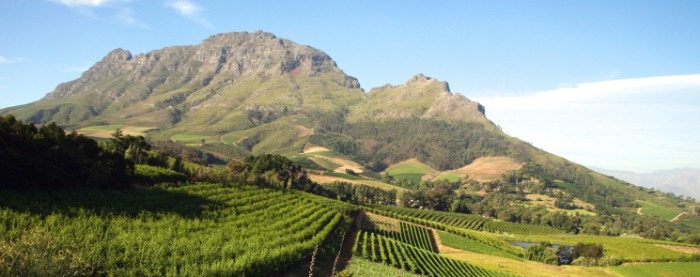Early Beginnings
Wine-making in South Africa is most frequently dated back to the “accidental” founding of the Cape of Good Hope settlement in 1647 A.D. by the Dutch. A hundred and fifty years after Vasco da Gama mapped out the area, one of the East India Company’s Indiamen, the Nieuwe Haerlem, wrecked in Table Bay during a storm. Luckily no crew or supplies were lost. The captain of the ship was able to load most of the cargo on the remaining fleet vessels to continue back home to Holland. Leendert Janszen, a junior merchant, was to stay behind with about 60 crewmen and protect the remaining supplies that wouldn’t fit into the holds[1]. Janszen set up a temporary stronghold, named the “Sand Fort of the Cape of Good Hope”, and got to work creating a livable space. Upon his return to Holland a year later, in Janszen’s report of the events, suggested that a refresh station be fully built on the Cape[2].
Jan van Riebeeck, who was on that ship that brought Janszen back to Holland, led the development of the new colony. Landing in 1652 with 90 settlers, van Riebeeck set up a more permanent supply station on the Cape of Good Hope to help ships make repairs and restock supplies for the remaining trip to India for the various exotic spices.

The gap in medical understanding led the Dutch and others to believe that eating grapes would prevent scurvy, so one of the tasks on van Riebeek’s “to-do” list from the Dutch leadership was to establish a vineyard. The first clippings were from the German Rheingau regional. However, the shipment of these clippings in damp sailcloth prevented them from taking root upon arrival. The next set of clippings, Muscat Blanc à Petits Grains and Muscat of Alexandria, were more successful. The first vintage of wine was produced in 1659 and exported back to Batavia[3].
The East India Company allowed freed employees to buy land and grow wine grapes around the colony, but only for their own consumption. The market for wine produced in the colony grew abroad. As it grew, the East India Company brought a winemaker from Alsace along with wine-making equipment and a cooper to make oak wine barrels in the colony. The result of all of this was the first winery built in the area[3].
Growth
After van Riebeeck was succeeded by Simon van der Stel in 1679, the wine industry grew. Van der Stel was able to found the Constantia estate, 750 hectares devoted to growing grapes. He smartly planted rows of European oak trees to shield the vines from the strong winds from Cape Doctor. Records show that van der Stel imported many grape varieties. Some of those were:
- the Spanish Sherry grape Palomino (known locally as “White French”),
- Chenin blanc (known as “Steen”),
- and Semillon (known as “Green Grape”).
He also had a variety of Muscat grapes planted, including the those from the earlier local vineyards (Muscat Blanc à Petits Grains and Muscat of Alexandria) and another that is suspected to be Muscat Hamburg.
Van der Stel expected the best from his estate and the rest of the wine producers in the region. He imposed large penalties for those who did not follow the best procedures. His strict attitude towards these producers paid off, however, as the wines produced in the Cape soon had a prestigious reputation across Europe.
Over the years, many different cultures influenced the Cape of Good Hope. The French influenced wine-making in the Cape during the 1690s after the French Huguenots arrived. Later, in the 1700s, the Dutch continued to share their technology, bringing their technique of fortifying wine to the Cape.
In the 1800s, the wine industry saw several large shocks that severly impacted the production in negative ways. There were oidium and phylloxera epidemics that deflated the industry for decades and caused some wine-growers to abandon their crop for good, turning to other sources of income.
After WWI, the South African government formed the Koöperatieve Wijnbouwers Vereniging van Zuid-Afrika (KWV), roughly translated to Co-operative Winemakers Union’ of South Africa, in 1918[4]. The KWV was eventually able to set policies and prices for the wine industry in South Africa in similar ways that the USDA controls and restricts yields in the United States.
By 1924, almost all (~95%) vineyard owners belonged to the KWV. This created stability in the wine industry, but also scuttled some growth and innovation[4].
You can find the history of other locations too, just by clicking here.
Sources
1) A Brief History Of The Castle Of Good Hope, Cape Town
Lee-Shay Collison – https://theculturetrip.com/africa/south-africa/articles/a-brief-history-of-the-castle-of-good-hope-cape-town/
2) The Dutch Indiaman, the Nieuwe Haerlem, is wrecked in a storm in Table Bay
Anonymous – http://www.sahistory.org.za/dated-event/dutch-indiaman-nieuwe-haerlem-wrecked-storm-table-bay
3) History of South African wine
https://en.wikipedia.org/wiki/History_of_South_African_wine
4) A Short History of Winemaking in South Africa
http://www.ellerman.co.za/blog/a-short-history-of-winemaking-in-south-africa/
History of Wine in South Africa
http://www.worldwidewinetours.com/southafrica/south-africa-wine/
South African Wine – History
http://www.vineyardvarieties.com/history-of-south-african-wine.htm
Vintage: the story of wine
Hugh Johnson – Simon and Schuster – 1989






